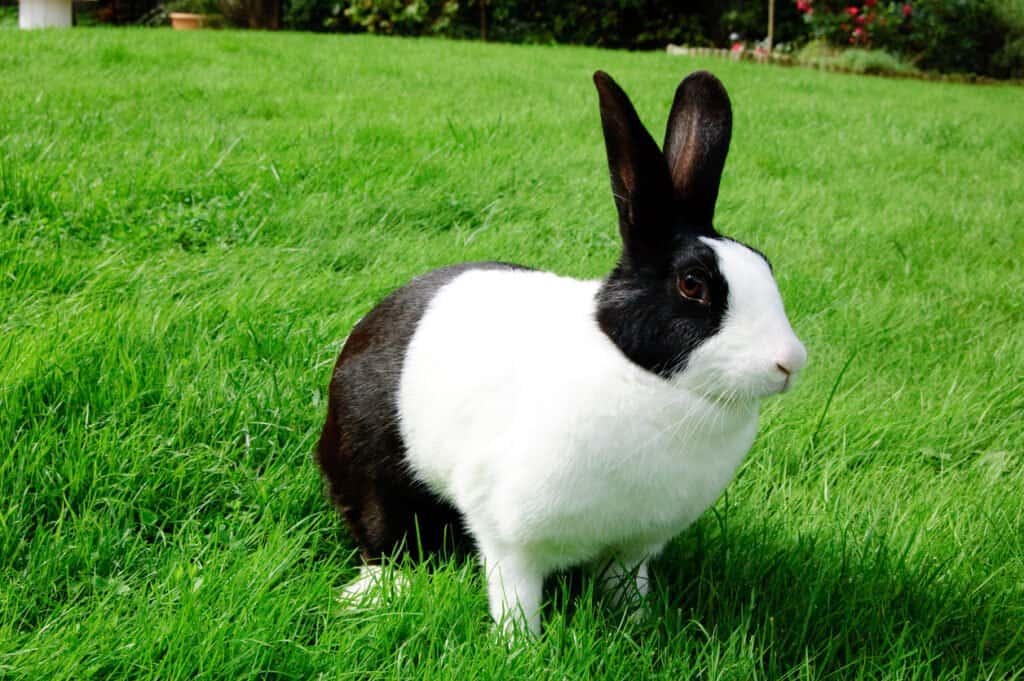Pet rabbits are popular choices for those looking for a small, soft creature to own. Before you welcome your new family member into your home, check out everything you need to know and buy in order to ensure a seamless transition. Here’s your pet rabbit guide!
Before Buying A Rabbit
One of many things you will need to consider before buying a rabbit is whether your family lives a lifestyle suited to this pet. There are also some costs and living space considerations to keep in mind.
Rabbits may cost $20-$100, depending on the breed and where you acquire your new pet. Supplies for your new bunny may average $100-$200, including pens, litterboxes, and feeding dishes.
RELATED: Bunny vs. Rabbit — the 3 Key Differences

Most rabbits are relatively low-maintenance, although you’ll need to ensure their pens and litterboxes are clean. Your rabbit won’t take up a lot of space but will appreciate the time spent loose in the house or outside in a playpen.
How much does a rabbit cost?
A rabbit from a local animal shelter or rescue may cost $5-$20 to adopt. On the other hand, purebred rabbits from breeders may range from $50-$100 and above. Show-quality rabbits will cost the most, especially if they are a relatively rare breed.
In most cases, the costs will be the highest when you first acquire the bunny. Most rabbits live 8-12 years, so prospective owners will want to consider these costs when purchasing their new friend. Initial prices, minus the cost of buying or adopting the rabbit, will average $100-$200.
The cost of food, including timothy hay, pellets, and vegetables, averages $10-$15 a month. Litter costs about $8 a for 10 liters. Most rabbits will cost you around $20 monthly. A cage or hutch will usually cost $40-$200 or more.
Most healthy rabbits require only an annual vet visit, which is $40-$100, depending on your area. If the only vets in your area who treat rabbits are exotic species vets, the visits will likely exceed $100. Veterinary insurance for rabbits costs about $20 monthly. You’ll want to expect to pay about $500 a year to care for your rabbit.
New Owner Shopping List: What To Buy
Bringing home a new rabbit requires having everything necessary to keep these animals content. Bunnies need to have a safe place to live and the right food. Your new furry friend will feel more at home with everything he needs to settle in and adjust.
In addition to food, a rabbit also needs bowls that make his food and water accessible. A litterbox to help keep his living area clean and something soft that he can lie on will make the hutch or cage more like home. Other helpful items include a box where the bunny can hide out to feel more secure and grooming tools.
- Cage – Cages provide rabbits with safe places to live inside a home, away from other pets. Clear cube-shaped or wire cages are the most popular styles in the size you prefer.
- Hutch – If your rabbit spends time outside, a hutch might be an excellent option for your bunny. A hutch helps protect your pet from the elements while allowing it to enjoy time spent outside. Here are the best rabbit hutches — reviewed and ranked — to help you make the best purchase for your rabbit.
- Exercise Pen – Unless you opt to let your rabbit out loose inside the house, an exercise pen is worthy of consideration. These enclosures are also perfect for supervised outdoor exercise.
- Litterbox – A small litterbox similar to what you would use for a cat will help everything clean. If the rabbit lives in the house, you may want to consider a box with a screen or cover. Here is the best litter box we’ve found.
- Water Bottle or Bowl – A water bottle that easily attaches to the cage will help your rabbit have constant access to water. You can use a water bottle that is similar to those used by guinea pigs — here are the best water bottles we have found. If a bowl is more practical for the circumstances, a size suitable for a cat or small dog will work nicely.
- Blanket or Towel – A small blanket or towel will give your bunny something comfortable to lie on. Another advantage is providing a little extra warmth on chilly nights.
- Box or “Hidey House” – A hidey house for a rabbit or a small box with a hole is a good idea. These boxes or houses give your bunny a place to hide for a greater feeling of security.
- Hay Rack – This rack makes hay more accessible to your rabbit. Using a rack also keeps the grass off the floor and out of the water bowl.
- Hair Comb – Combs help keep long-haired rabbits’ coats looking neat. The teeth on combs effectively get through the coats and help remove dead hairs.
- Hair Brush – Shorter-haired rabbits will benefit from a brushing every week. Brushes with soft bristles are the most comfortable for regular use on your pet.
- Nail Clippers – Rabbits’ claws can scuff up hardwood or tile floors. When you use clippers appropriate for rabbits, you can keep your bunny’s nails at a reasonable length.
Ongoing Needs: What You Need to Care For Your Rabbit
Rabbits aren’t very high-maintenance for the most part, but you can expect to buy supplies regularly. These supplies will keep your rabbit well-fed and clean.
- Hay – Most of your bunny’s diet will involve quality hay, like timothy hay. Depending on what you have for storage, you may want to buy hay in whole bales from a feed store or smaller bales from pet stores.
- Pellets – Pellets help provide crucial nutrients that your furry friend may not get from hay alone. Most pellets come in large enough bags to last three or four months.
- Fresh Vegetables – Fresh vegetables are an excellent, occasional treat to give your rabbit some variety. Farmer’s markets are excellent sources for veggies that your pet will love.
- Litter – A constant supply of fresh litter will keep your bunny’s living area clean. Wood shavings or wood pellets are also helpful as litter, but avoid brands used for stoves containing accelerants if using pellets.
Exercise and Ongoing Care
Exercise
Rabbits usually enjoy the chance to get out of their cage and explore. An exercise pen or room in the house is perfect for quenching your pet’s thirst for adventure. Some bunnies like trips down the sidewalk on a leash and harness.
Although there are rabbit toys available, most are easy to keep occupied with everyday household items. Paper towel and toilet paper rolls offer lots of fun. Most bunnies will also enjoy being able to hide in a cardboard box.
RELATED: Why Do Rabbits Binky?
Cleaning
Cleaning out your rabbit’s cage and bedding are tasks that are also necessary for your pet’s wellbeing. Changing the litter regularly is always a good idea because these animals are often uncomfortable with dirty boxes. The floor of the cage or hutch should also be swept.
Laundering blankets, towels, or beds is a good idea when they become messy. Your pet will be much more comfortable and healthy with clean bedding. One thing to keep in mind is to be careful about using natural detergents without harmful ingredients.
Vet Care
Most rabbits will do well with an annual checkup unless some condition requires ongoing care. If your pet requires medication to treat a health issue, this is another monthly or quarterly cost to consider. Bunnies in the U.S. won’t need vaccines regularly.
Feeding your Rabbit
Rabbits are grazers who will eat continuously throughout the day. The majority of a rabbit’s diet will be hay. Although bunnies enjoy pellets and vegetables, these are usually a smaller part of their diet. Access to fresh water is always necessary.
Free-feeding hay is best by keeping the hay rack continually supplied. When you feed pellets or vegetables, these should be put down once daily. You won’t need to refill these foods as often as you provide the hay.
Check out this article called “What Do Bunnies Eat?” to learn more.
How Long Will Your Rabbit Live
Regardless of the breed, most pet rabbits live 5-12 years. Dwarf breeds live the longest lives, with larger rabbits often living for a shorter time. Mixed-breed rabbits may live longer lifespans because of fewer problems with inbreeding.
The quality of your bunny’s nutrition is one of the factors with the most significant influence on his lifespan. When a bunny gets the necessary nutrition, there is a lesser chance of severe health conditions. Regular vet visits will help you catch health conditions while they are easier to treat.
RELATED: Wild vs. Domestic Rabbits — What’s the Difference?
Common Health Issues For Rabbits
Skin disorders, respiratory infections, and digestive problems are among the most common health problems in rabbits. Urine burn from a wet hutch floor and infections on the dewlap area in the front of the neck are the most common skin disorders. Ringworm is another common skin issue but is easy to treat.
Pasteurellosis is a type of upper respiratory infection that most rabbits will get at some point and rhinitis. Bunnies can also develop pneumonia, often after having had an upper-respiratory infection. These diseases are usually treated with antibiotics or other medications.
Hairballs are one of the most common digestive issues, especially in long-haired bunnies. Increasing the amount of dietary fiber is one of the easiest ways to correct hairballs. Bacterial infections that cause diarrhea are sometimes common and usually treated with supportive fluids.
RELATED: What’s a Baby Rabbit Called?
Where to Buy your Rabbit
You can buy rabbits from breeders or pet shops, although many consider bunnies that come from breeders tend to be healthier than their pet shop counterparts. Rescues or animal shelters are also popular sources for rabbits. If your area has a 4H club, you may also be able to find a bunny that needs a home here.
If you already have a hutch or cage available, you will only need to think about how to confine your rabbit to bring him home. A crate or carrier in a cat or small dog size should work best for your new pet. One thing that you will want to avoid is transporting your new pet loose inside a car.
Special Considerations With Rabbits
There are some considerations to consider when keeping rabbits with other pets, especially dogs or cats. Most dog breeds see rabbits as prey to chase. Cats may also see bunnies as prey animals.
One of the best ways to avoid problems is limiting opportunities for confrontations. Your rabbit should have time out of his cage when your dog or cat is not in the room. Another thing to remember is to never leave your bunny unattended around the other pets.
Keeping A Pet Rabbit: Read BEFORE Buying FAQs (Frequently Asked Questions)
Are rabbits easy to care for?
Rabbits are not high-maintenance, but they are moderately difficult to care for because of their unique housing and feeding needs.
Are rabbits high or low-maintenance pets?
Rabbits are considered high-maintenance pets because they require a special diet and housing and sometimes require a specialist vet.
Can rabbits be left alone for long?
If you need to be away between two and four days, you can leave a rabbit alone if he has sufficient food and water.
How do I litterbox-train my rabbit?
Keep your rabbit in his cage with the litterbox and only let him out after he has used the box.
Do rabbits bite people?
Rabbits don’t usually intentionally bite their owners unless started or frightened.
Thank you for reading! Have some feedback for us? Contact the AZ Animals editorial team.




